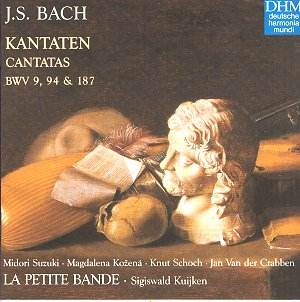Johann Sebastian BACH
(1685-1750)
Cantata BWV9: 'Es ist das Heil uns kommen her'
Cantata BWV94: 'Was frag ich nach der welt'
Cantata BWV187: 'Es wartet alles auf dich'
 Midori Suzuki (soprano),
Magdalena Kozená (mezzo soprano),
Midori Suzuki (soprano),
Magdalena Kozená (mezzo soprano),
Knut Schoch (tenor), Jan van der Crabben (baritone)
La Petite Bande
Sigiswald Kuijken
Rec 20-22 November 1999, Athen
 Deutsche Harmonia
Mundi 05472 77528 2 [68.26]
Deutsche Harmonia
Mundi 05472 77528 2 [68.26]
Crotchet
Amazon UK Amazon US

What were Bach's performing forces for his cycles of cantatas at Leipzig?
No-one knows for sure, and those who are best informed don't necessarily
agree. They were not large, certainly, but were the vocal contributions
one-to-a-part even in the choruses and chorales? That is what Sigiswald Kuijken
advocates here, following the precedent of Joshua Rifkin, and the results
are interesting and vital, though by no means conclusive.
These three performances were recorded live, with a commendably silent audience
and a nicely resonant church acoustic. The music-making has great spontaneity
and once Kuijken begins a movement, the tempo feels as though it could not
possibly be otherwise - which in Bach of course it can. For this is musicianship
of some distinction, Bach delivered with great concern for textural details
and expressive turn of phrase. There is none of that ultra-fast driving of
tempo which can (to my ears) mar Eliot Gardiner's Bach; nor the leaden dragging
of which the older German school could sometimes be guilty.
The 'orchestra', if we can call it that, numbers fourteen including organ
continuo. None of these pieces requires large forces; only flutes and oboes
join the strings. But each, of course, has its own special flavour. The latest
of them - from 1735 - has the earliest BWV number, confirming that the numbering
of the cantatas makes no chronological sense. Cantata No. 9 includes some
splendid concertante writing for the woodwinds, and develops its material
from the chorale melody sung by the soprano, based on a hymn by Paul Speratus
dating from 1523. No. 94 was composed in 1724. It is another chorale-cantata,
this time featuring an obbligato flute, quite beautifully played by Sigiswald's
brother Barthold. Cantata No. 187 opens with a lively ensemble (chorus) founded
upon an orchestral ritornello. More than any single movement among these
cantatas, this exemplifies the strengths of the performances: lively, bouncing
rhythms, clear and balanced textures, bright-toned voices with excellent
articulation. The performances convince entirely, though as one who loves
the richness of Bach's choral writing, I cannot help but feel I'd like them
even more with just a few extra voices added as appropriate to the choruses
and chorales.
The production and publication standards are of the highest order, with insert
notes by Kuijken himself and full texts and translations.
Terry Barfoot

